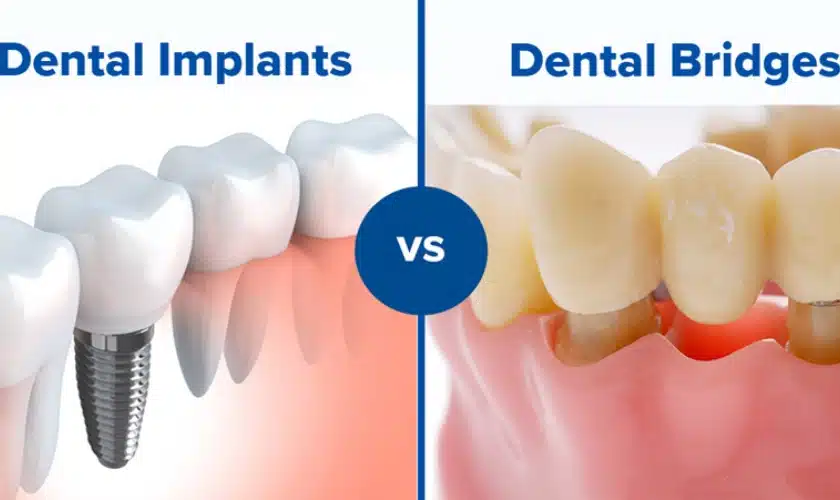The Ultimate Guide To Dental Sense
Table of ContentsGet This Report on Dental SenseFascination About Dental SenseGetting The Dental Sense To WorkFacts About Dental Sense Uncovered
are clinical tools operatively dental implanted right into the jaw to recover an individual's ability to chew or their appearance. They give support for synthetic (fake) teeth, such as crowns, bridges, or dentures. When a tooth is shed as a result of injury or condition, a person can experience problems such as quick bone loss, malfunctioning speech, or changes to eating patterns that lead to pain.Oral implant systems include an oral implant body and dental implant abutment and might additionally consist of an abutment fixation screw. Cosmetic dentistry services. The dental implant body is operatively put in the jawbone instead of the tooth's root. The oral implant joint is generally connected to the implant body by the abutment fixation screw and prolongs through periodontals right into the mouth to support the attached synthetic teeth
(https://telegra.ph/Transform-Your-Smile-Dental-Implants-Root-Canal-Procedures-and-Professional-Teeth-Whitening-01-11)Framework of The Dental Implant System selecting oral implants, speak with your dental copyright concerning the prospective benefits and threats, and whether you are a prospect for the procedure. Things to consider: Your total health and wellness is an essential consider determining whether you are a great candidate for oral implants, for how long it will certainly require to recover, and the length of time the implant may remain in place.
Smoking might affect the healing process and lower the long-lasting success of the dental implant. The healing procedure for the dental implant body may take a number of months or longer, throughout which time you typically have a short-term abutment instead of the tooth. the oral implant treatment: Meticulously follow the dental health instructions offered to you by your oral provider.
The Only Guide for Dental Sense
Implant failing can result in the demand for another surgery to fix or change the implant system. Brings back the ability to eat Brings back cosmetic look Aids keep the jawbone from diminishing as a result of bone loss Maintains the wellness of the bordering bone and gums Aids keep surrounding (close-by) teeth secure Improves quality of life Damages to bordering all-natural teeth during implant positioning Injury to the surrounding tissues throughout surgical treatment, such as sinus opening Injury during surgical treatment (for example, fracture of surrounding jawbone) Inadequate function, such as seeming like the teeth do not bite with each other normally A feeling that the tooth hangs or twisting in location arising from a joint screw loosening Implant body failing (looseness of the dental implant body) because of systemic infection, which may be more likely in people with uncontrolled diabetes mellitus because of regional infection in bone and gum tissues supporting the implant body because of delayed recovery, which might be more probable in people that smoke Trouble cleansing the gum tissues around the implant, causing bad oral health Neglected periodontal disease Post-surgical pins and needles as a result of nerve impingement or damages Always inform healthcare suppliers and imaging professionals that you have oral implants prior to any type of magnetic resonance imaging (MRI) or x-ray treatments.
FDA is not knowledgeable about any kind of damaging events reported for MRI or x-ray procedures with oral implants. Oral implants systems are commonly constructed from materials that comply with international consensus criteria of the International Company for Standardization (ISO) or ASTM International. These requirements have details of what makes a risk-free material.

A dental implant is a structure that changes a missing tooth. With screw-like gadgets, the doctor inserts a dental implant right into the jawbone, and it works as an anchor for a synthetic tooth, called a crown. A tool called an abutment attaches the fabricated tooth to the oral implant. The crown is customized to fit the person's mouth and match the shade of their teeth.
Not known Factual Statements About Dental Sense
Some people are not qualified for dental implant surgery. It is for oral doctors to operate on individuals with: acute illnessuncontrollable metabolic diseasebone or soft cells illness or infectionIf these concerns are solved, an individual can have the surgical procedure. In, dental specialists avoid running on individuals with: If people with any of the above undertake dental implant surgery, there is a higher threat of the dental implant falling short.

Oral implant surgical procedure is a customized process. It's not the same for everybody. The following provides a general summary of what you can expect your dental practitioner, oral cosmetic surgeon, periodontist or prosthodontist to do: Place the dental implant operatively. Offer you time to heal. Affix the article and final crown, bridge or denture.
Next off, your doctor will thoroughly place the oral implant into your jaw. Your specialist will reposition your periodontals and close the cut with stitches. If your dental implant is near the front of your mouth, your dental practitioner will certainly make a momentary tooth for you to put on up until you heal. In this way, you won't have a void in your smile while you recuperate.
Some Known Questions About Dental Sense.
During the healing phase, your jawbone ought to fuse to the oral implant. This process can take anywhere from three to 9 months.
As soon as your dental implant heals, your dental expert can attach the abutment (small adapter blog post) and basics your last repair (crown, bridge or denture). This generally takes concerning one hour to finish and might call for a 2nd minor surgical procedure. You should not feel any kind of pain during your oral implant procedure due to the fact that your company will use medication to numb your gum tissues.